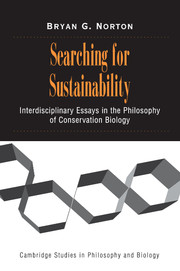Book contents
- Frontmatter
- Contents
- Searching for Sustainability
- General Introduction: An Interdisciplinary Experiment
- I PRAGMATISM AS AN ENVIRONMENTAL PHILOSOPHY
- II SCIENCE, POLICY, AND POLICY SCIENCE
- III ECONOMICS AND ENVIRONMENTAL SUSTAINABILITY
- IV SCALING SUSTAINABILITY: ECOLOGY AS IF HUMANS MATTERED
- V SOME ELEMENTS OF A PHILOSOPHY OF SUSTAINABLE LIVING
- VI VALUING SUSTAINABILITY: TOWARD A MORE COMPREHENSIVE APPROACH TO ENVIRONMENTAL EVALUATION
- 23 Commodity, Amenity, and Morality: The Limits of Quantification in Valuing Biodiversity
- 24 The Cultural Approach to Conservation Biology
- 25 Evaluation and Ecosystem Management: New Directions Needed?
- 26 What Do We Owe the Future? How Should We Decide?
- 27 Environmental Values and Adaptive Management, with Anne Steinemann
- Index
- References
27 - Environmental Values and Adaptive Management, with Anne Steinemann
Published online by Cambridge University Press: 21 January 2010
- Frontmatter
- Contents
- Searching for Sustainability
- General Introduction: An Interdisciplinary Experiment
- I PRAGMATISM AS AN ENVIRONMENTAL PHILOSOPHY
- II SCIENCE, POLICY, AND POLICY SCIENCE
- III ECONOMICS AND ENVIRONMENTAL SUSTAINABILITY
- IV SCALING SUSTAINABILITY: ECOLOGY AS IF HUMANS MATTERED
- V SOME ELEMENTS OF A PHILOSOPHY OF SUSTAINABLE LIVING
- VI VALUING SUSTAINABILITY: TOWARD A MORE COMPREHENSIVE APPROACH TO ENVIRONMENTAL EVALUATION
- 23 Commodity, Amenity, and Morality: The Limits of Quantification in Valuing Biodiversity
- 24 The Cultural Approach to Conservation Biology
- 25 Evaluation and Ecosystem Management: New Directions Needed?
- 26 What Do We Owe the Future? How Should We Decide?
- 27 Environmental Values and Adaptive Management, with Anne Steinemann
- Index
- References
Summary
INTRODUCTION
While it is a truism that environmental policy is ultimately driven by “social values,” there is currently considerable confusion regarding how to understand and assess social values, and corresponding confusion regarding the role of values in the broader process of environmental policy formation, implementation, and management. In this paper, we set out to describe an alternative direction for environmental value studies, a process that emphasizes pluralism, participation, and iteration rather than just simple elicitation of preferences and preference aggregation. Our goal will be to provide an approach that will help to better understand environmental values, especially in public processes for environmental management.
Our approach to environmental values is based on theory, but our theory is not one of the usual ones, such as utilitarianism, or a theory that nature or its elements have “rights” or something like that. Ours is a theory about process rather than a theory about ultimate values. We take the view that, since we live in a diverse society – and neither hope nor expect that this will change – the problem is not to decide which theory of ultimate value is correct, but rather to design a process by which diverse societies – with many voices expressing many worldviews and ultimate values – can act in a way that will tend toward a working consensus on environmental policy decisions (Norton, 1991).
- Type
- Chapter
- Information
- Searching for SustainabilityInterdisciplinary Essays in the Philosophy of Conservation Biology, pp. 514 - 548Publisher: Cambridge University PressPrint publication year: 2002

